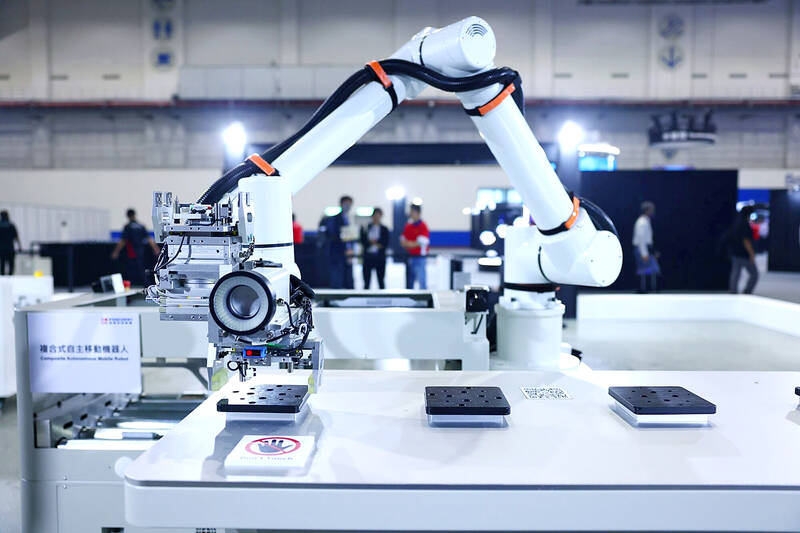The official manufacturing purchasing managers’ index (PMI) gained 1.4 points to 51.4 last month, bouncing back to expansion mode, thanks to improving business orders and industrial output, the Chung-Hua Institution for Economic Research (CIER, 中華經濟研究院) said yesterday.
The latest PMI reading, which seeks to capture the pulse of the manufacturing industry, with points above 50 suggesting expansion, came after companies built up inventory ahead of US president-elect Donald Trump’s inauguration next month to dodge tariff hikes, the monthly report said.
“The business pickup had more to do with risk aversion rather than a reflection of an increase in confidence,” CIER president Lien Hsien-ming (連賢明) said.

Photo: Annabelle Chih, Bloomberg
As such, the rebound is weak and likely short-lived, depending on how the tariff drama pans out, Lien said.
The sub-index on new business orders rallied 3.6 points to 55.5, while the measure on industrial production added 4 points to 54.5, the report showed.
The reading on inventory climbed 1.4 points to 48.6, but customers’ inventory lost 1.6 to 44.5, both indicating a conservative approach, Lien said.
Companies generally feel uneasy over Trump’s pledge of tariff hikes on imports from around the world and could not afford to be optimistic, he said.
Indeed, many turned increasingly pessimistic about business prospects, with the measure on the six-month outlook slipping 0.4 points to 47.9, he added.
However, domestic steelmakers were cautiously optimistic, aided by China’s introduction of stimulus measures to invigorate its economy.
The sub-index on raw material prices stayed in expansion territory at 52.2, albeit down 1.8 points from one month earlier, the report said.
The S&P Global Taiwan Manufacturing Purchasing Managers’ Index reached similar observations, coming in at 51.5, which it attributed to improvements in new business orders and industrial production.
Firms saw better business demand last month, with gains in both domestic and international markets, S&P Global Market Intelligence said.
“Price and margin pressures remained apparent, with costs rising markedly, but output charges up only modestly,” S&P Global economics director Paul Smith said in a statement.
However, employment fell, as firms continued to focus on bolstering productivity, instead of expanding the payroll, S&P Global said.
Taiwan’s non-manufacturing sectors remained resilient, with the non-manufacturing index edging up 0.8 points to 54.6, rising for a 25th consecutive month, CIER said in a separate report.
The advent of the high sales season for domestic demand contributed to the healthy showing, the institute said.
The six-month business outlook softened 0.9 points to a marginal 50.6, as real-estate brokers grew negative about housing transactions following broad credit controls introduced by the central bank in September.
Wholesale operators also held negative views, but financial institutes, hospitality facilities and retailers were all upbeat about their business going forward, it said.

The US dollar was trading at NT$29.7 at 10am today on the Taipei Foreign Exchange, as the New Taiwan dollar gained NT$1.364 from the previous close last week. The NT dollar continued to rise today, after surging 3.07 percent on Friday. After opening at NT$30.91, the NT dollar gained more than NT$1 in just 15 minutes, briefly passing the NT$30 mark. Before the US Department of the Treasury's semi-annual currency report came out, expectations that the NT dollar would keep rising were already building. The NT dollar on Friday closed at NT$31.064, up by NT$0.953 — a 3.07 percent single-day gain. Today,

‘SHORT TERM’: The local currency would likely remain strong in the near term, driven by anticipated US trade pressure, capital inflows and expectations of a US Fed rate cut The US dollar is expected to fall below NT$30 in the near term, as traders anticipate increased pressure from Washington for Taiwan to allow the New Taiwan dollar to appreciate, Cathay United Bank (國泰世華銀行) chief economist Lin Chi-chao (林啟超) said. Following a sharp drop in the greenback against the NT dollar on Friday, Lin told the Central News Agency that the local currency is likely to remain strong in the short term, driven in part by market psychology surrounding anticipated US policy pressure. On Friday, the US dollar fell NT$0.953, or 3.07 percent, closing at NT$31.064 — its lowest level since Jan.

Hong Kong authorities ramped up sales of the local dollar as the greenback’s slide threatened the foreign-exchange peg. The Hong Kong Monetary Authority (HKMA) sold a record HK$60.5 billion (US$7.8 billion) of the city’s currency, according to an alert sent on its Bloomberg page yesterday in Asia, after it tested the upper end of its trading band. That added to the HK$56.1 billion of sales versus the greenback since Friday. The rapid intervention signals efforts from the city’s authorities to limit the local currency’s moves within its HK$7.75 to HK$7.85 per US dollar trading band. Heavy sales of the local dollar by

The Financial Supervisory Commission (FSC) yesterday met with some of the nation’s largest insurance companies as a skyrocketing New Taiwan dollar piles pressure on their hundreds of billions of dollars in US bond investments. The commission has asked some life insurance firms, among the biggest Asian holders of US debt, to discuss how the rapidly strengthening NT dollar has impacted their operations, people familiar with the matter said. The meeting took place as the NT dollar jumped as much as 5 percent yesterday, its biggest intraday gain in more than three decades. The local currency surged as exporters rushed to